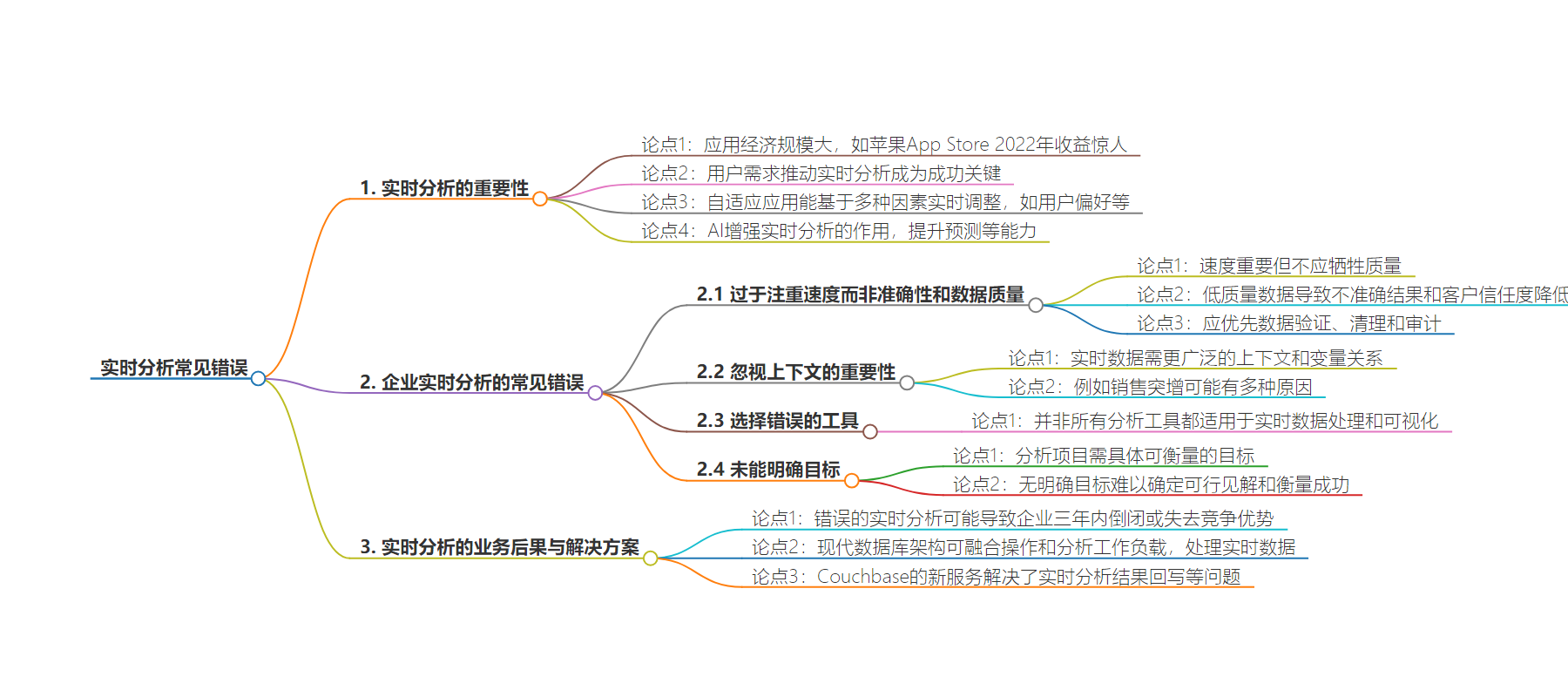包阅导读总结
1. 关键词:实时分析、数据质量、工具选择、目标定义、业务影响
2. 总结:
– 当今企业面临从应用数据中提取关键洞察的挑战,实时分析结合 AI 能提供个性化用户体验,但目前采用率低。
– 文中指出实时分析存在的 4 个常见错误及可能的业务后果,还提到现代数据库架构能解决相关问题。
3. 主要内容:
– 实时分析的重要性
– 应用经济规模大,用户需求推动实时分析成为成功关键。
– 自适应应用能基于多种因素实时调整,AI 增强了其个性化和响应能力。
– 常见错误
– 重速度轻准确和数据质量,应注重数据验证和清理。
– 忽视数据的上下文关联,要深挖变量关系。
– 选错分析工具,应选适合实时处理和可视化的。
– 未明确目标,应设定具体可衡量的目标。
– 业务后果
– 41%企业称若应用不满足用户期望,3 年内可能倒闭。
– 46%认为会在竞争中失利。
– 解决方案
– 现代数据库架构可融合工作负载,处理实时数据。
– Couchbase 新服务解决了实时分析结果回写等问题。
思维导图:
文章地址:https://thenewstack.io/4-roadblocks-to-real-time-analytics-and-how-to-get-it-right/
文章来源:thenewstack.io
作者:Rahul Pradhan
发布时间:2024/8/22 19:39
语言:英文
总字数:860字
预计阅读时间:4分钟
评分:84分
标签:实时分析,生成式 AI,数据质量,运营效率,客户体验
以下为原文内容
本内容来源于用户推荐转载,旨在分享知识与观点,如有侵权请联系删除 联系邮箱 media@ilingban.com
In today’s app-driven world, organizations are drowning in data. The challenge they face is extracting critical insight from these applications’ operational data using real-time analytics. When coupled with AI, this could open the door to hyper-personalized and immediate “adaptive applications.” These provide the kind of customized, dynamic and responsive user experiences that customers are increasingly demanding. So why do just 17% of enterprises today have the ability to perform real-time analytics on large volumes of data?
Finding the right tools and technologies is the first step to carving out a competitive advantage in an increasingly AI-centric universe.
Why Real Time Matters
The app economy is big business. Apple’s App Store ecosystem alone generated a staggering $1.1 trillion in total billings and sales for developers in 2022. And as users demand more relevant and immediate experiences, attention has focused on real-time analytics as a critical steppingstone to success.
This is especially true of so-called “adaptive applications,” a new cohort of dynamic apps capable of adjusting behavior and features in real time based on factors such as user preferences, environmental conditions, data inputs and changing circumstances. An adaptive retail app might enable businesses and advertisers to offer the right products and services to the right target audience at the right time. Similarly, a booking app with adaptive functionality might be regularly updated based on real-time travel information, events and user history to suggest personalized journeys and deals.
This hyper-personalization and responsiveness are supercharged by the power of AI. Integrating generative AI with real-time analytics offers numerous benefits, including enhanced predictive capabilities, personalized user experiences, improved operational efficiency and enabling businesses to respond to events in real time by adjusting strategies. This significantly enhances use cases ranging from fraud and anomaly detection to customer service and retail checkout experiences. By leveraging these technologies, businesses can gain deeper insights, respond faster to changes, and deliver better products and services to their customers.
Four Ways Organizations Are Going Wrong
Yet despite the obvious benefits, adoption remains slow, with many businesses yet to fully exploit the benefits of real-time data. The following four common mistakes may be compounding these challenges:
1. Too Much Focus on Speed Over Accuracy and Data Quality
As their moniker suggests, timeliness is critical to these applications. But speed shouldn’t come at any cost. The old adage “garbage in, garbage out” applies here: If a service draws on poor-quality data, it will not deliver the intended outcomes. Outdated or incomplete datasets will only lead to inaccurate insights and erode customer trust in the application. Organizations should instead prioritize data validation checks and cleaning, as well as regular audits, to maintain data integrity and accurate results.
2. Ignoring the Importance of Context
Real-time data requires broader context and correlation to help derive accurate insights. That’s why organizations must dig deeper to uncover the true relationship between variables. For example, a sudden spike in sales of an item may be due to increased consumer demand, macroeconomic conditions such as a shortage of complementary goods, climate-related indicators or perhaps promotional campaigns. Correlation does not imply causation.
3. Choosing the Wrong Tools
Not all analytics tools are created equal. It’s critical that organizations choose technologies tailor-made for real-time data processing and visualization. Failure to do so could lead to bottlenecks, latency and accuracy issues.
4. Failing to Clearly Define Objectives
Analytics projects will rarely reap the desired rewards without specific, measurable goals. Organizations must therefore define clear objectives, such as improving customer retention by a certain amount within a set time frame. This will help guide data collection and analysis efforts. Without clear goals, it’s difficult to identify actionable insights or measure success.
Time for Real-Time Analytics
There are potentially serious business consequences to getting real-time analytics wrong in this context. Some 41% of enterprises claim they could go out of business within three years if their apps no longer meet user expectations. An even greater share (46%) believe they’ll lose out to the competition if this happens. Yet while these capabilities are already being used by mature, tech-focused businesses, the vast majority of organizations struggle to get hold of the right tools and know-how to leap barriers like siloed data systems.
Fortunately, modern database architectures can weave together both operational and analytical workloads, while ingesting and processing real-time data. Crucially, this can be done in a single environment. This avoids moving data from databases to data warehouses, and eliminates the need for costly extract-transform-load (ETL) processes in online transactional processing (OLTP) and online analytical processing (OLAP) systems, which can also introduce latency.
Couchbase’s new Capella columnar service solves a problem that has stumped the database industry for decades: Ensuring real-time analytic results are immediately written back to the operational database and the applications they serve. It brings zero ETL data streaming across multiple heterogeneous data sources (Couchbase, MongoDB, MySQL and PostgreSQL) and across data formats (csv, tsv, parquet, avro and JSON). It separates compute and storage, along with an optimized columnar storage format for JSON, to deliver faster real-time insights to applications.
YOUTUBE.COM/THENEWSTACK
Tech moves fast, don’t miss an episode. Subscribe to our YouTubechannel to stream all our podcasts, interviews, demos, and more.
